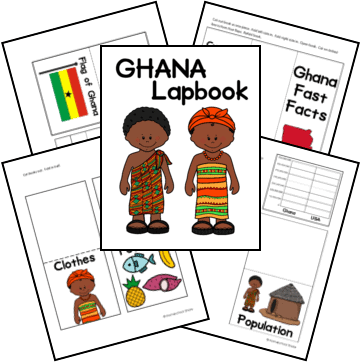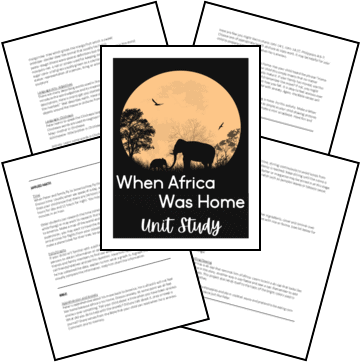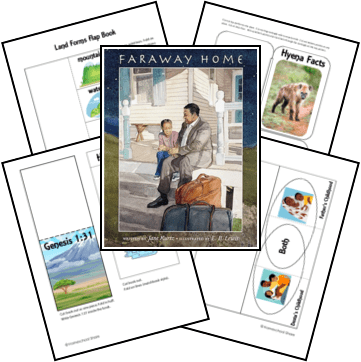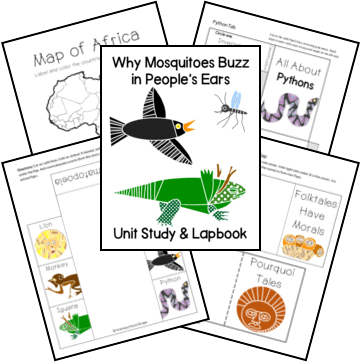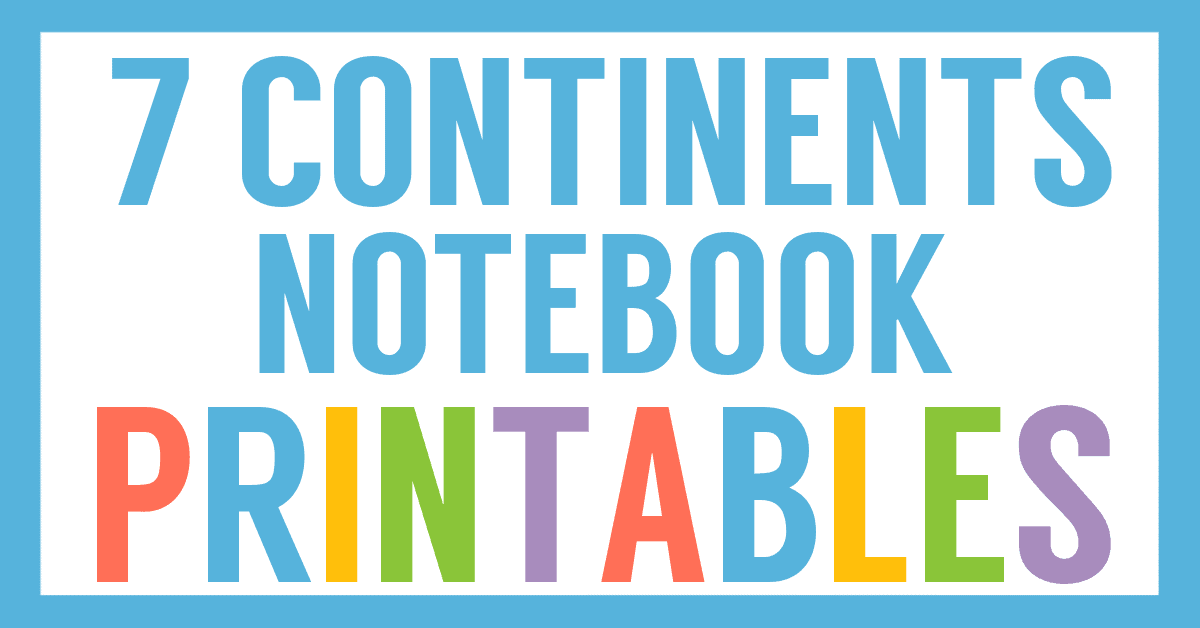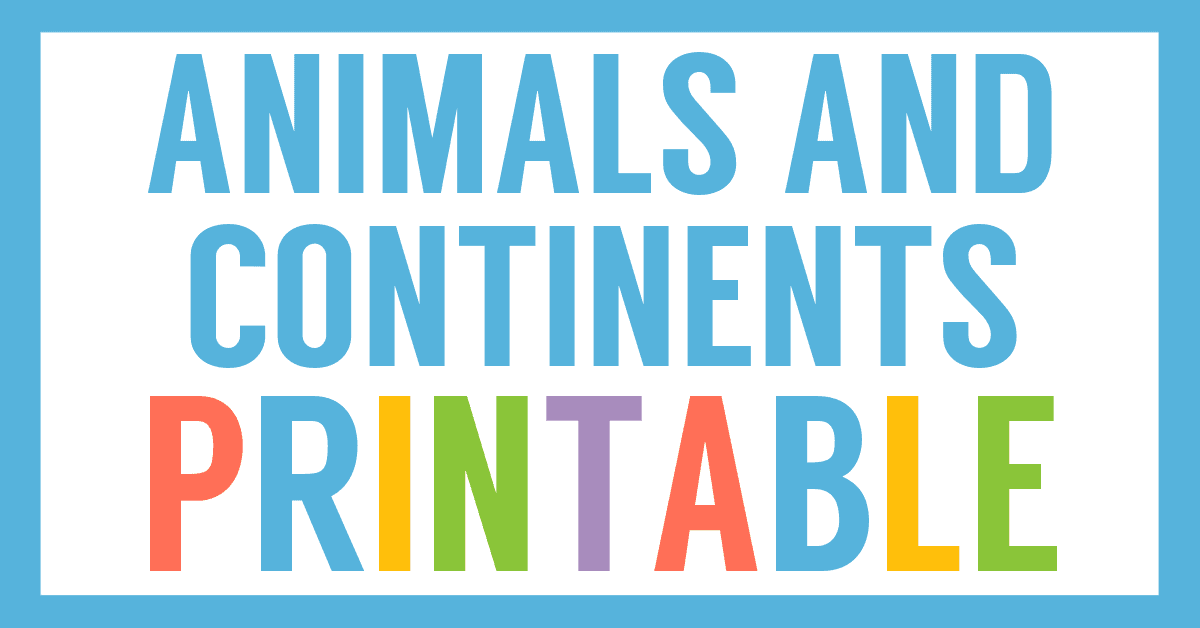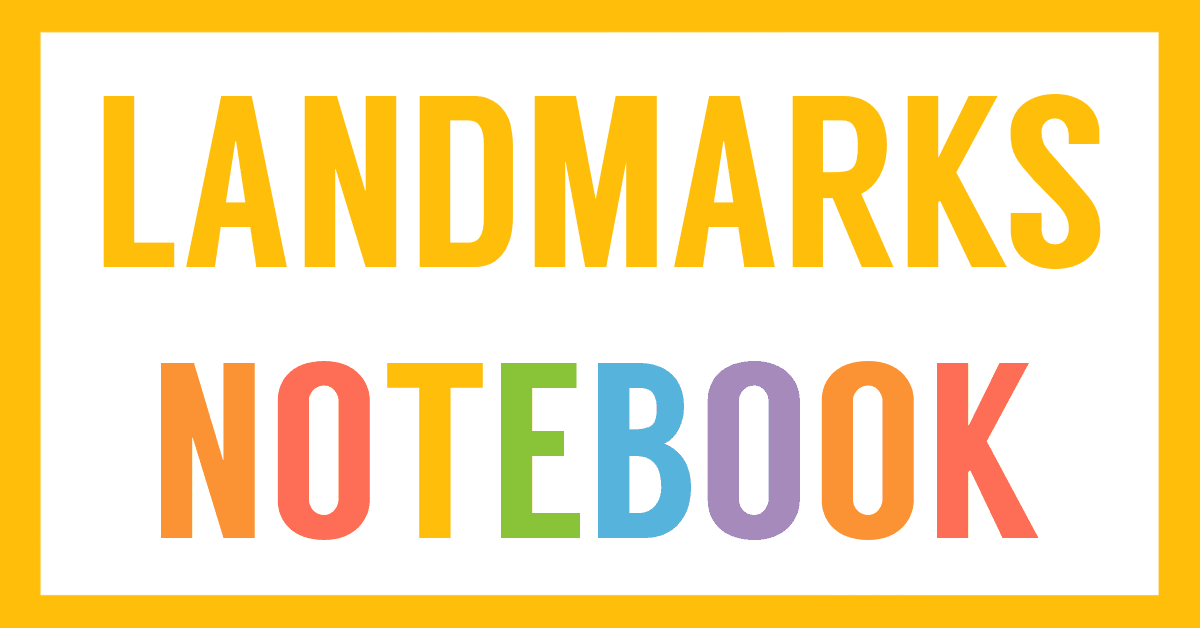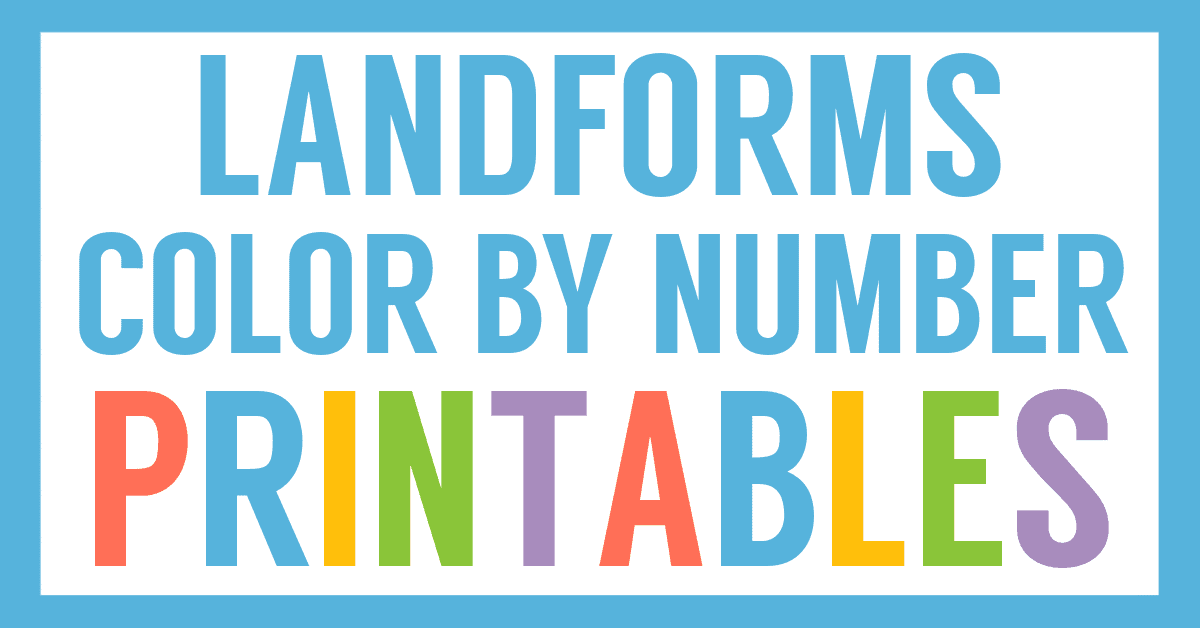Affiliate Disclaimer
We sometimes use affiliate links in our content. This won’t cost you anything, but it helps us to keep the site running. Thanks for your support.
We’re off to West Africa to visit the country of Ghana with our Ghana Lapbook study.
You can find more geography lapbooks here.
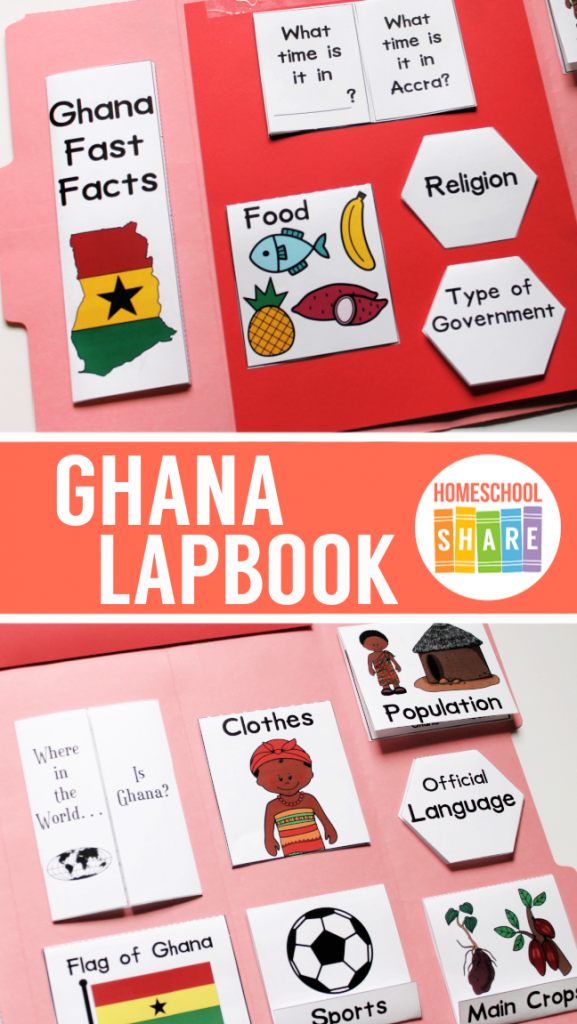
Ghana Lapbook Information
Flag
Ghana’s flag is a tricolor flag which means it’s the type that has three colored stripes, either horizontal or vertical. This is a very popular type of flag.
The top stripe is red which stands for the blood of people who fought for Ghana’s independence.
The middle stripe is gold which represents Ghana’s wealth.
The bottom stripe is green which stands for Ghana’s forests.
The flag has a black star in the middle which reminds people of Ghana’s freedom.
Currency
The unit of currency in Ghana is the cedi. One hundred pesewas make up one cedi.
Climate
It’s hot in Ghana all year round, but people still notice the changes of season. There is a very hot season from February to May, then a rainy season from June until August or September; and in December the harmattan (har-MATT-an) arrives. During this time of the year, the Sahara Desert to the north of Ghana causes the sky to become hazy and dusty, and it starts to feel much cooler.
Food
Vegetables and fruit are the main foods in Ghana. Ghanaians also eat beans and fish.
Fou-fou is a common food. Ghanaians make fou-fou by boiling and mashing yams, plantains, or cassava roots until they become a thick mixture, much like really thick mashed potatoes. They let it cool slightly then use their hands to shape the mixture into balls which thy often eat with stews. Most Ghanaians eat food with their hands, using the fou-fou as a scoop.
Ghanaians usually make stew with beans. They may add tomatoes, spicy peppers, onions, and ginger. The may add a little meat or fish. People often add chopped peanuts to thicken and flavor the stew.
Most Ghanaian meals include fruit. You might find bananas, coconuts, and pineapples at the table. They also often fry or boil plantains which look like and taste like bananas.
Ghanaians do not eat sweets with most meals. They’re usually reserved for special occasions and holidays.
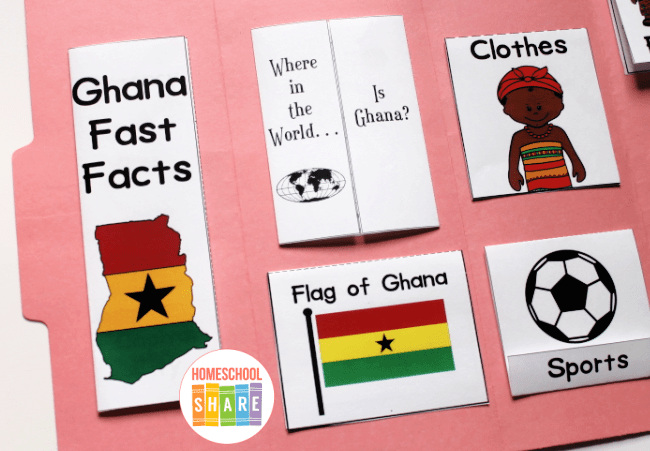
Clothing and Jewelry
Ghanaians wear several styles of clothing. Some wear the same type of clothing as people in North America. Others wear traditional clothing.
Some Ghanaian women wear ntamas (nn-TAH-mahs). A ntama is a large piece of brightly colored cloth that they wrap around their bodies.
Ghanaians make most ntamas out of kente (KEN-tuh) cloth. Cloth and cloth designs are very important in Ghanaian culture. Making kente cloth is a tradition in some villages.
On special occasions, such as the birth of a child or the death of a loved one, people wear particular colors or patterns because they have a special meaning.
Women are responsible for spinning cotton into thread. They dye the thread bright colors.
Men and boys are responsible for weaving the colorful threads into kente cloth. They weave kente cloth into narrow strips of about 5 inches wide. Then, they sew these strips together to make ntamas.
Beads are an important part of women’s traditional dress in Ghana, and many Ghanaian families own beads that have been in the family for generations. The oldest Ghanaian beads were made in Europe and brought to Africa hundreds of years ago by traders, who exchanged them for valuable Ghanaian goods.
Sports and Games
Soccer is the most popular sport in Ghana where they call it football. Many people play soccer while many others watch and cheer for their favorite soccer teams. Ghana’s national soccer team’s called the Black Stars. Can you guess why?
Other popular sports in Ghana include boxing and swimming.
Ghanaian kids love playing Mancala, one of the world’s oldest and most popular games. It’s played on a hollowed-out wooden board and small objects like dried beans, pebbles, small seashells, or marbles. Ghanaians call this game oware (oh-WAHR-ay) which they play with 48 beans and 12 cups. Player drop small objects into the cups and pick them up. They follow a certain pattern. The player who collects the most objects wins.
Holidays and Celebrations
Ghanaians celebrate Independence Day on March 6 as Ghana won its independence from Great Britain on March 6, 1957. People participate in or watch parades and sing Ghana’s national anthem to celebrate the occasion.
Ghana celebrates many traditional celebrations which honor events such as weddings, births, and harvest. People wear their best clothes at these celebrations. Some people sing and play drums. Other people dance to the music.
A durbar (DURH-bath) is an important part of traditional celebrations. A durbar starts with a parade through a village. Leaders wear their best ntamas. Everyone else follows the leaders. They all go to the center of the village. There, villagers honor their highest-ranking leader.
Religion
Ghanaian people have great respect for their ancestors and they like to give thanks to them when something special happens, such as the arrival of a new baby in the family or a good harvest.
Christianity, which was introduced to Ghana by the Europeans, is also very popular, especially in the coastal regions.
In the flat lands of northern Ghana, most people are Muslim.
National Geographic Site
National Geographic has an amazing Ghana page for your student to explore.
Ghana Lapbook Example
This lapbook sample was made with one file folder and one piece of cardstock taped to the center to create a center extension.
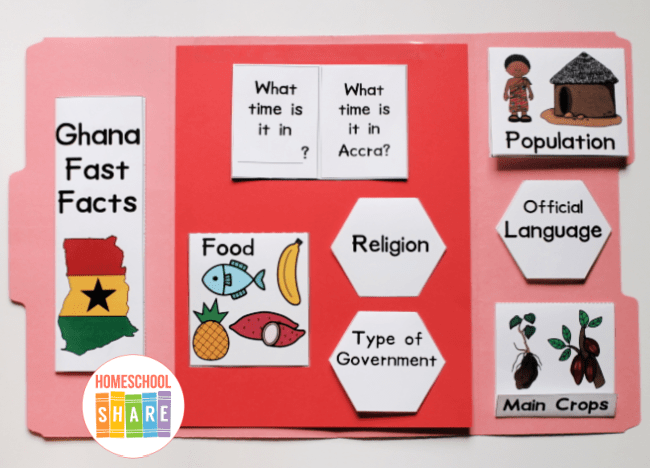
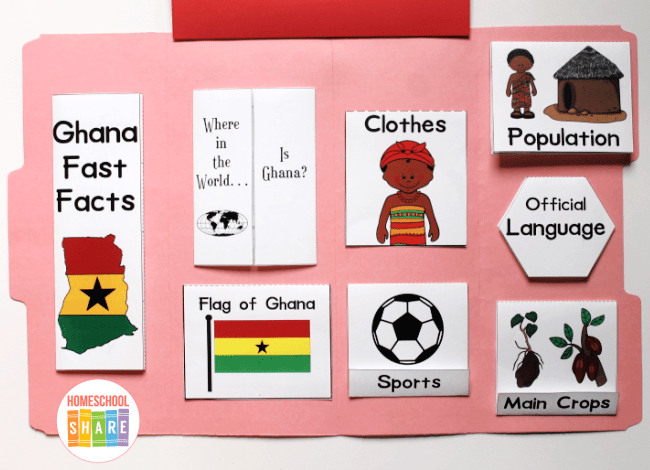
How to Get Started with Your Ghana Lapbook
Follow these simple instructions to get started with the Ghana Lapbook.
- If you want, go to your local library and check out books about Ghana.
- Print the Ghana Lapbook.
- Choose and prepare the lapbook mini-books you want to use with your student.
- Enjoy a week of reading and learning all about Ghana!
Download Your Ghana Lapbook
Simply click on the image below to access your free Ghana Lapbook.
Explore Our Africa Resources
If your student would like to learn more about the beautiful, diverse continent of Africa, try these unit studies and lapbooks:
When Africa Was Home is set in Malawi.
Faraway Home is set in Ethiopia and contains an Ethiopia Lapbook in the printables.
Why Mosquitoes Buzz in People’s Ears is a West African folktale that is worth reading and exploring.

